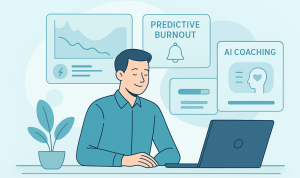In today’s fast-paced corporate world, stress and emotional overload are common. Employees often struggle to process what they feel, which over time can erode engagement, productivity, and well-being. But there is a growing tool in the mental health tech landscape: AI journaling. By combining reflective writing with intelligent prompts and behavioral insights, AI journaling offers a modern path toward emotional resilience AI and better balance at work.
In this article, we explore how AI journaling works, why it can matter in the workplace, how you can design or adopt it, and what pitfalls to watch out for.
Why Journaling Matters: A Quick Review
Journaling has long been a tool in therapy and self-development. Studies show that writing about one’s emotions and experiences can:
- Reduce symptoms of depression, anxiety, and stress.
- Increase emotional clarity and help people “distance” themselves from distressing thoughts.
- Lead to fewer sick days and reduced healthcare visits.
- Improve resilience and psychological adjustment in high-stress populations (e.g. hospital workers) when using guided expressive writing.
In one expressive writing trial among healthcare workers during COVID-19, participants using writing interventions showed greater reductions in depression symptoms compared to controls.
Journaling’s psychological mechanism partly rests on emotional disclosure theory (Pennebaker), which posits that organizing chaotic thoughts through writing reduces cognitive load and emotional burden.
However, traditional journaling often suffers from drop-off or inconsistency. That is where AI can add value.
What Is AI Journaling?
At its core, AI journaling is a reflective writing app enhanced with intelligence: the system may:
- Prompt users with contextually relevant questions
- Analyze entries to detect emotional trends, sentiment shifts, or linguistic markers
- Adjust future prompts or suggestions based on previous entries
- Combine passive behavioral signals (e.g. typing speed, time of day, activity patterns) with self-reports
In more advanced systems, akin to the MindScape project, contextual AI journaling blends behavior sensing (sleep, location, app usage) with LLMs to generate personalized prompts and insights. In their exploratory study, they reported reduced negative affect and PHQ score decreases over eight week.
Another recent tool, Resonance, offers memory-based suggestion prompts: when a user logs a memory, it suggests small future actions based on that memory. Their trial showed measurable improvements in mood and depression indicators.
These systems merge classic expressive writing benefits with intelligent adaptation, turning journaling from static practice to evolving support.
Benefits of AI Journaling in the Workplace
When deployed in a corporate or organizational context, AI journaling offers several advantages:
1. Scalable reflective support
Rather than relying exclusively on coaches or therapists, AI journaling can deliver digital self-reflection opportunities at scale, accessible 24/7.
2. Continuous tracking and early warnings
With prompt analysis of writing patterns and sentiment, AI can play the role of an AI mood diary, flagging emotional drift before things get worse.
3. Personalization leading to engagement
By tailoring prompts based on user history, the system improves relevance and may sustain use better than static journals.
4. Data to inform wellness strategy
Aggregated anonymized insights can feed AI wellbeing dashboards, helping HR or wellness teams spot emerging stress clusters or emotional trends.
5. Linkage with other AI systems
When combined with tools like predictive sentiment analysis or burnout forecasting, journaling becomes a node in a richer mental health pipeline.
6. Support for resilience building
Regular reflection helps users make sense of stressors, integrate learnings, and develop resilience over time.
In sum, AI journaling is a bridge between individual reflection and organizational mental health strategy.
How to Design or Deploy an AI Journaling System
If you’re a business or wellness leader looking to adopt or pilot AI journaling, here’s a stepwise roadmap:
Step 1: Define goals and scope
Decide whether the objective is early detection, emotional growth, stress reduction, or all three.
Step 2: Choose data modalities
- Self-reports / writing entries
- Behavioral signals (app usage, typing cadence, time stamps)
- Optional sensors / wearables if available
More data modalities help, but simplicity promotes adoption.
Step 3: Prompt design
Start with a baseline question set (e.g., “How are you feeling today? What challenges did you face? What helped you cope?”) and iteratively refine.
Step 4: Sentiment & trend analysis
Use NLP models to score entries for sentiment, emotional intensity, keyword occurrences, or emotional shifts over time.
Step 5: Personalization & feedback
Adapt prompts and suggestions based on prior entries or detected trends. I.e., skip generic prompts if the user is stable; offer guided reflection when mood drifts.
Step 6: Human escalation
When the system detects significant risk patterns (e.g. sustained negative tone, self-harm markers), flag for counselor outreach or trigger an integrated support flow.
Step 7: Monitor outcomes
Track usage, retention, changes in emotional tone, employee feedback, and mental health outcomes such as reductions in leaves or reported stress.
Step 8: Scale with care
Roll out gradually, communicate transparently (especially about privacy), and iterate based on feedback.
When you implement in phases and maintain transparency, adoption tends to be higher.
Use Cases & Example Scenarios
- Remote teams under stress: An AI journaling tool prompts end-of-day reflections, surfaces mood dips, and nudges micro-activities when negative drift is detected, all while feeding insights to leadership wellness dashboards.
- Frontline professionals (healthcare, manufacturing): Workers can log short entries post-shift; the system detects cumulative stress and triggers debrief prompts or rest reminders. This can also support personalized wellness AI strategies across roles.
- Leadership & managers: Leaders journaling about challenges gain awareness of stress patterns and alignment cues; aggregated trends help HR spot teams suffering from emotional fatigue.
- Onboarding or change management: During major organizational change, journaling prompts guide employees to express concerns, reflect on adaptation, and gradually normalize transitions.
Risks, Challenges & Best Practices
While promising, AI journaling is not without pitfalls. Some challenges and mitigations:
| Challenge | Possible Mitigation |
| User fatigue or drop-off | Keep prompts short, minimal friction, encourage “any time” short entries |
| Privacy concerns | Encrypt entries, allow anonymity, ensure opt-in, clear data policies |
| Misinterpretation of sentiment | Use conservative thresholds, human review for flags |
| Bias in language models | Train on diverse data sets; audit for unfairness across cultures/languages |
| Overreliance on AI | Emphasize the tool is supportive, not diagnostic; always include human escalation paths |
In pilot phases, plan to monitor engagement metrics closely and refine prompt strategies or thresholds.
Measuring Impact & ROI
To evaluate if your AI journaling initiative is adding value, track:
- Adoption & retention rates (how many users continue logging over weeks)
- Sentiment trend shifts (e.g. average tone improvement over time)
- Correlation with mental health outcomes (surveys, clinical measures)
- Employee feedback / perceived value
- Impact on absenteeism / presenteeism (mental health improvements should reduce lost productivity)
- Linkages to other AI pipelines (journaling insights feeding into predictive models or real time sentiment analysis)
These metrics guide iterative enhancements and investment decisions.
Sample Prompts to Kick Off Journaling
Here are prompts you could trial in your reflective writing app design:
- “What emotions did you notice today, and what may have triggered them?”
- “Which moments made you feel calm, supported, or energized?”
- “What challenge remains unresolved, and what is one small step you might take?”
- “If you were advising a colleague in your situation, what would you say to them?”
Over time, the system can personalize prompts based on past responses (e.g. skip neutral topics, focus on recurring stressors).
Summary
AI journaling holds real promise for enhancing emotional resilience AI and building workplace balance. By combining a smart AI mood diary experience with mindfulness journaling AI techniques, businesses can give employees a low-friction, scalable tool for digital self-reflection.
When tied into AI wellbeing dashboards, insights can help organizations spot emotional strain early. As use grows, integration with predictive models, burnout systems, or wellness frameworks can deepen value.







